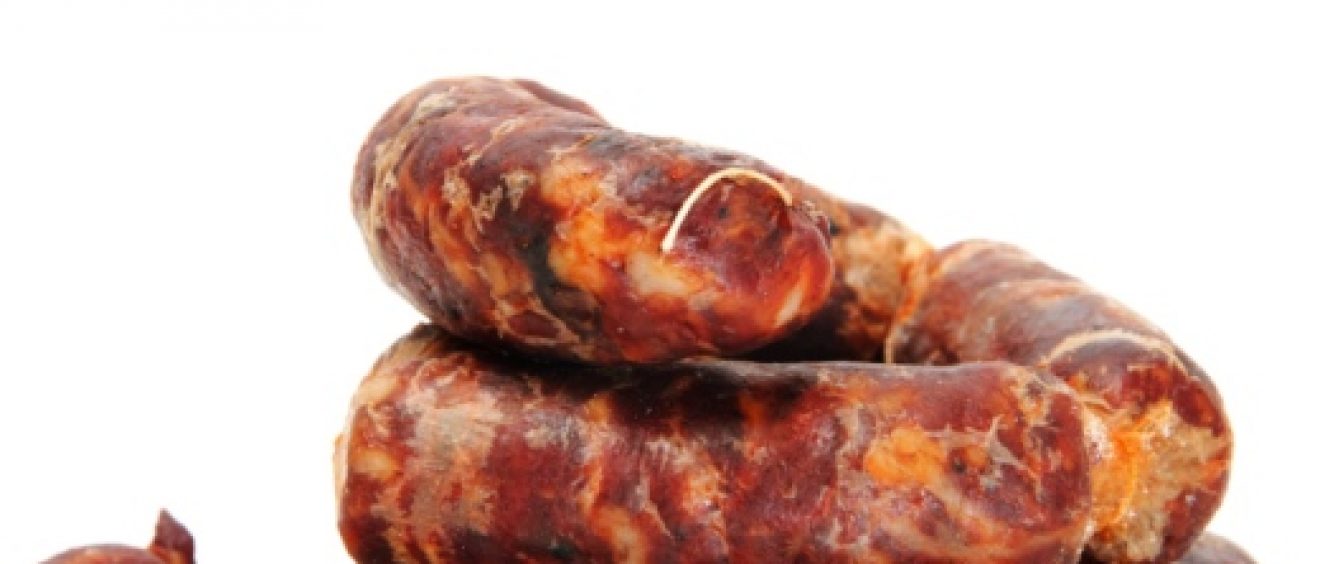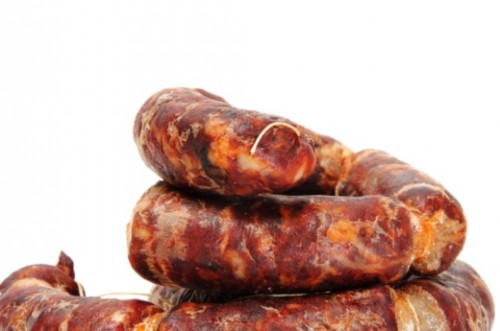
Daddy, Where Does Sausage Come From?

Sausage. We all love it, laugh at it, and sometimes shudder at it…but when it comes down to it, we’re always left with the same question — just WTF is it anyway? The old joke goes that sausage is the parts of the animal swept off the factory floor after everything else is made, but the truth is it’s much more complicated than that. Fortunately, Kim from Good Bite is here with a guest blog to demystify the whole sausage-making process — for home cooks.
The ingredients
The first and most important ingredient is the meat. Whether making poultry, pork, or lamb sausages, fat is key in the success of the final product. Ample fat content (about 15 to 30 percent) is responsible for creating a smooth consistency and complex of flavor. For red meats, choose higher fat cuts like Boston butt or shoulder, and if opting for chicken or turkey, choose the darker cuts like the thigh.
The meat will need to be ground, so you have a few options here. Ask the butcher to grind the meat at the counter (which should be no problem at all), or take the meat home and grind it in a food processor. No grinding machines necessary.
Seasonings will make up the rest of the flavor profile, so decide what type of sausage you are aiming for and go from there. Common spices include any mixture of peppercorn, fennel, anise, cloves, garlic, thyme, cayenne, sugar, and allspice. It may be necessary to add a drizzle or two of olive oil, depending on the fat content of the chosen meat, as well as a trickle of water to keep the moisture locked in.
The process
Making sausages without the casings is an enjoyable, tangible experience done almost exclusively with the hands. If the meat has not yet been ground, cut it into small ½-inc to 1-inch cubes and place it in a food processor fitted with the metal blade. Pulse the machine until the meat is coarsely chopped — not so much that it becomes mushy. And, if you are feeling particularly adventurous, go ahead and finely chop the meat yourself with a sharp knife. Have patience, as it will take several minutes, and be careful with that knife.
Once the meat is ground, add any chosen seasonings and get to mixing. Using your hands, work the meat until the spices are well incorporated. Now test the flavor of the mix: roll a mini patty and fry it in a bit of oil. If you like what you taste, proceed to shape the sausages. Otherwise, make any adjustments to seasonings and proceed.
To shape into patties, dampen hands with cool water and form sausages into 2-inch wide patties and ½-inch thick. Cook them up right away or wrap tightly and store in the freezer. To cook the patties, fry in a small amount of oil over medium-high heat about 5 minutes per side, until no longer pink inside. More cooking time will be needed if using frozen patties.
For shaping into links, you will use plastic wrap to substitute for animal casing. Place large dollops of the meat on top of a sheet of plastic wrap, and shape it into a cylinder of your desired length, about 4 to 6 inches. Wrap the plastic around the link, rewrap with another sheet of plastic, and tie the ends with twine. Repeat until the meat mixture is used up. To cook the links, poach gently in a pot of water heated to just under a simmer — no bubbles should come to the surface. Cook like this until the center of the links reaches 160 degrees, from 30 to 45 minutes. Remove from water, cool, remove wrapping, and serve.
Ready to get mixing? Here are a couple of sausage formulas to get your hands dirty. Roll up your sleeves and roll out the sausage.
Anyone else made sausages at home? What spices/extras do you use? Give us some tips!




Where does sausage come from? Heaven.